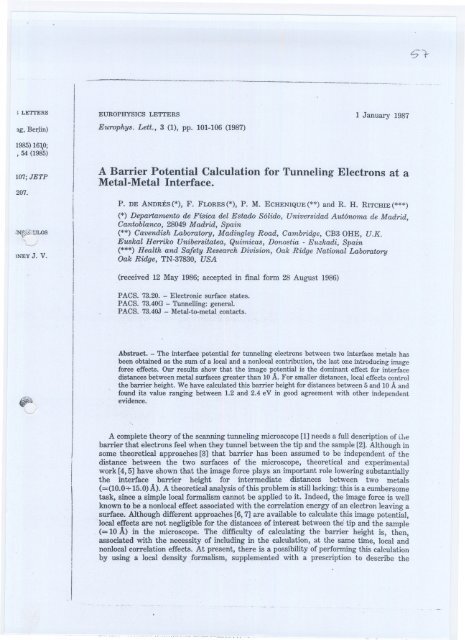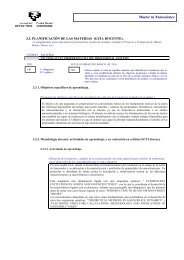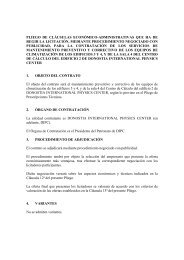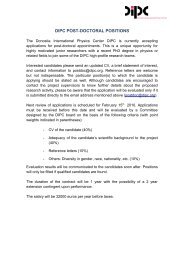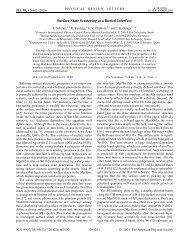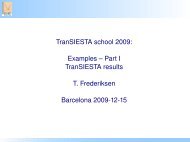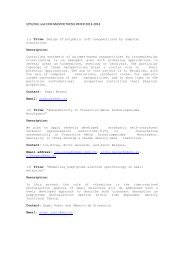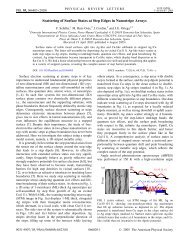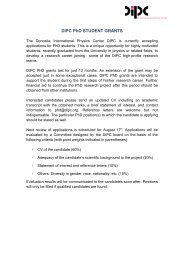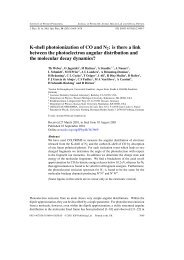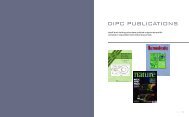A Barrier Potential Calculation for Tunneling Electrons at a Metal ...
A Barrier Potential Calculation for Tunneling Electrons at a Metal ...
A Barrier Potential Calculation for Tunneling Electrons at a Metal ...
You also want an ePaper? Increase the reach of your titles
YUMPU automatically turns print PDFs into web optimized ePapers that Google loves.
---<br />
0'1-<br />
; LE'ITERS EUROPHYSICS LETTERS<br />
ag, Ber;lin)<br />
Europhys. Lett., 3 (1), pp. 101':106 (1987)<br />
1 January 1987<br />
1985)16\0;<br />
, 54 (1985)<br />
107;JETP<br />
207.<br />
:Nf:~VLOS<br />
)NEY J. V.<br />
A <strong>Barrier</strong> <strong>Potential</strong> <strong>Calcul<strong>at</strong>ion</strong> <strong>for</strong> <strong>Tunneling</strong> <strong>Electrons</strong> <strong>at</strong> a<br />
<strong>Metal</strong>-<strong>Metal</strong> Interface.<br />
P. DE ANDRÉS(*),F. FLORES(*),P. M. ECHENIQUE(**)and R. H. RITCHIE(***)<br />
(*) Departamento de Física del Estado SólÜÜJ,Universidad Autónoma de Madrid,<br />
Cantoblanco, 28049 Madrid, Spain<br />
(**) Cavendish Labor<strong>at</strong>ory, Madingley Road, Cambridge, CB30HE, U.K.<br />
Euskal HerriJco Unibersit<strong>at</strong>ea, Quimicas, Donostia - Euzkadi, Spain<br />
(***) Health and Safety Research Division, Oak Ridge N<strong>at</strong>ional Labor<strong>at</strong>ory<br />
Oak Ridge, TN-37830, USA<br />
(received 12 May 1986; accepted in final fonn 28 August 1986)<br />
PACS. 73.20. - Electronic surface st<strong>at</strong>es.<br />
PACS. 73.40G ;...Tunnelling: general.<br />
PACS. 73.4OJ - <strong>Metal</strong>-to-metal contacts.<br />
~<br />
Abstract. - The interface potential <strong>for</strong> tunneling electrons between two interface metals has<br />
been obtained as the sum of a local and a nonlocal contribution, the last one introducing image<br />
<strong>for</strong>ce effects. Our results show th<strong>at</strong> the image potential is the dominant effect <strong>for</strong> interface<br />
distances between metal surfaces gre<strong>at</strong>er than 10 Á. For smaller distances, localeffects control<br />
the barrier height. We have calcul<strong>at</strong>ed tms barrier height <strong>for</strong> distances between 5 and 10 Á and<br />
found its value ranging between 1.2 and 2.4 eV in good agreement with other independent<br />
evidence.<br />
A complete theory of the scanning tunneling microscope [1] needs a full description oí Ole<br />
barrier th<strong>at</strong> electrons feel when they tunnel between the tipand the sample [2]. Although in<br />
some theoretical approaches [3] th<strong>at</strong> barrier has been assumed to be independent oí the<br />
distance between the two surfaces of the microscope, theoretical and experimental<br />
work [4,5] have shown th<strong>at</strong> the image <strong>for</strong>ce plays an important role lowering substantially<br />
the interface barrier height <strong>for</strong> intennedi<strong>at</strong>e distances between two metals<br />
(=(10.0+15.0)Á). A theoretical analysis oítbis problem is stilllacking: this is a cumbersome<br />
task, since a simple local <strong>for</strong>malism cannot be applied to it. Indeed, the image <strong>for</strong>ce is well<br />
known to be a nonlocal effect associ<strong>at</strong>ed with the correl<strong>at</strong>ion energy oí an electron leaving a<br />
surface. Altbougb different approacbes [6,7] are available to calcul<strong>at</strong>e tbis image potential,<br />
local effects are not negligible <strong>for</strong> tbe distances of interest between tbe' tip and tbe sample<br />
. (= 10 Á) in tbe microscope~ The difficulty of calcul<strong>at</strong>ing the barrier beigbt is, tben,<br />
associ<strong>at</strong>ed witb tbe necessity of including in tbe calcul<strong>at</strong>ion, <strong>at</strong> the same time, local and<br />
nonlocal correl<strong>at</strong>ion effects. At present, tbere is a possibility oí per<strong>for</strong>ming tbis calcul<strong>at</strong>ion<br />
by using a local density. fonnalism, supplemented witb a prescription to describe tbe<br />
. - .. -.-. - --
Ct<br />
__ A .__~<br />
i~-:.;<br />
102 EUROPHYSICS LETTERS<br />
nonlocal correl<strong>at</strong>ion energy <strong>for</strong> electrons moving away from a surface [8, 9]. This is a<br />
cumbersome self-consistent calcul<strong>at</strong>ion, and in this paper we have followed a different<br />
approach by introducing s()me reasonable approxim<strong>at</strong>ions in the general expression <strong>for</strong> the<br />
self-energy of an electron moving <strong>at</strong> the interface.<br />
Figure 1 shows OUTmodel <strong>for</strong> a Au-W interface. We have sirnul<strong>at</strong>ed the two metals by<br />
me~s of a jellium model (<strong>for</strong> Au we take Tg=3.02 and <strong>for</strong> W Ts=2:5). The electronic charge<br />
--;<br />
20<br />
::J<br />
~<br />
'" 10<br />
c:<br />
x<br />
w<br />
~ o<br />
f/ Au<br />
'- Lb'1 C'<br />
\<br />
f~';~\<br />
'---'<br />
o<br />
-12 -1. o<br />
z (a..u.)<br />
1.<br />
8 12<br />
Fig. 1. - Jellium model <strong>for</strong> the Au-Winterface showingthe electronic density, the image planes (i.p.),<br />
the jellium edges and the infinite barriers (Lb.) <strong>for</strong> each surface.<br />
<strong>at</strong> the interface can be calcul<strong>at</strong>ed by using a localdensity <strong>for</strong>malism;the results of Smith and<br />
Ferrante [10] show th<strong>at</strong> the electron density of th<strong>at</strong> case is practically the superposition of<br />
the charges of the two independent surfaces. With thrs assumption, andusing now the<br />
values calcul<strong>at</strong>ed by LANGand KOHN[11] we can obtain the local charge and the barrier<br />
potential, Vxc(z) <strong>for</strong> the interface. In fig. 2, 3 and 4 we show these potentials <strong>for</strong> three<br />
different distances between the two crystals; we take d =5.4 A, 7.6 A and 9.7 A, d being<br />
the distance between the irnage planes of both crystals [11]. Two comments are relevant <strong>at</strong><br />
this point: i) first, notice th<strong>at</strong> the barrier is substantially decreased by the overlapping of the<br />
metal electronic charges; this cre<strong>at</strong>es a deeper' potential due to the local exchange and<br />
correl<strong>at</strong>ion energy. This result shows the irnportance of local effects in lowering the barrier<br />
height <strong>for</strong> tunneling electrons. ü) On the other hand, OUTcalcul<strong>at</strong>ionsshow th<strong>at</strong> the distance<br />
between the points defined by the crossing of Vxc(z) and the Fermi l~vel is close to d as<br />
defined above. Indeed, <strong>for</strong> the three cases, we find the effective length of the barrier to be<br />
5.7 A, 8.1 A and 10.1 A, respectively.<br />
In order to calcul<strong>at</strong>e the full potential seen by a tunneling electron, we start by<br />
introducing the nonlocal self-energy [12], I(r, r'; w). We are interested in calcul<strong>at</strong>ing this<br />
quantity <strong>at</strong> the Fermi energy, w = EF. Now, we notice th<strong>at</strong>, <strong>at</strong> the interface, the electronic<br />
density, n(z), is r<strong>at</strong>her low, and defines a local plasma frequency, wp(z), and a local Fermi<br />
momentum, kF(z). We find th<strong>at</strong> the following condition is well s<strong>at</strong>isfied: wp(z)>>k¡'(z)l2m.<br />
This suggests to use Hedin's approxim<strong>at</strong>ion [12] <strong>for</strong> I(r, r'; EF), and write<br />
I(r, r'; EF)=Isx(r, r') + !ICh(r= r'; w= O)O'(r- r') ,<br />
where ~sx(r, r') is the screened exchange interaction, independent of w, and<br />
ICh(r = r'; w= O) the Coulomb-hole potential, given by the self-interaction of a st<strong>at</strong>ic<br />
charge. Equ<strong>at</strong>ion (1) holds if the time of response associ<strong>at</strong>ed with the interface dielectric<br />
(1)<br />
.~~<br />
.fJ<br />
,~<br />
¡<br />
I""<br />
i,~<br />
'!~ ?i<br />
'* ~ '"<br />
~<br />
.?J<br />
~ f;..t<br />
~<br />
':~ :A\<br />
t ~<br />
l ""<br />
.:}<br />
~<br />
,:i,<br />
'R<br />
..',<br />
~.::<br />
'..<br />
.~<br />
'?}<br />
~<br />
'!J<br />
~ '.s<br />
?j;<br />
:i<br />
~¡(:<br />
~<br />
~¡E<br />
1<br />
'¡¡'<br />
.y,<br />
¡;-<br />
;f<br />
:;,<br />
.<br />
1:-<br />
,~<br />
~<br />
off<br />
.~ ~)<br />
.~<br />
¡:y¡ ...<br />
;,
18<br />
.- ~ ._. ---- __o,___~ ~_<br />
~S LETTERS<br />
This is a<br />
\ differeJ\t<br />
ion <strong>for</strong> the<br />
metals by<br />
nie charge<br />
P. DE ANDRÉS et al.: A BARRIER POTENTIAL CALCULATION FOR TUNNELlNG ELECTRONS ETC. 103<br />
o<br />
-0.1<br />
::J<br />
l,:,;-..<br />
i':<br />
'"<br />
b><br />
c:<br />
'-" EF<br />
"<br />
-0.2<br />
....<br />
12<br />
Ianes (i.p.),<br />
8mith and<br />
position oí<br />
~ now the<br />
he barrier<br />
<strong>for</strong> three<br />
\., d being<br />
'el~?Jt <strong>at</strong><br />
Jint.,- ..the<br />
1ange and<br />
he barrier<br />
_edistanee<br />
se to d as<br />
rrier to be<br />
start by<br />
l<strong>at</strong>ingthis<br />
electronie<br />
)Ca}Fermi<br />
~F
.. . . __ - -0_"_" -~ --" .-------.<br />
104 EUROPHYSICS LETTERS<br />
o<br />
-: ::><br />
:>..<br />
o.<br />
c:<br />
..<br />
EF<br />
lk'<br />
~.<br />
'.<br />
k;¡.;....<br />
~ ''1<br />
-<br />
Z(a..u.)<br />
4. 8 12<br />
Fig. 4. - <strong>Potential</strong> barrier in the Au-W interface <strong>for</strong> a distance between the image planes equal 10<br />
9.7 Á. As fig. 2 <strong>for</strong> the differents curves.<br />
function is short compared with the time an electr(m takes to travel an inter-electronic<br />
distance. Two typical frequencies appear in the interface dielectric function: the surface<br />
plasma frequency, ws, and the local plasma frequency, wp(z); on the other hand, in the<br />
tunneling region an electron crosses the interface With a velocity given by [13] - y2mrp,<br />
where rpis the tunneling barrier height. Conditions <strong>for</strong> using eq. (1) can be written as<br />
folIows: .<br />
wp(z) or ws» y(2mrp)/rs or ki-(z)/2m .<br />
These equ<strong>at</strong>ions are equivalent to the condition rs(z)« 40 <strong>for</strong> rp== (1+ 2) eV, which is welI<br />
s<strong>at</strong>isfied if d~ (10+ 15) Á. At larger distances, however, local effects start to be negligible, .<br />
the only significant frequency is ws, and eq. (1) is a good approxim<strong>at</strong>ion to the self-energy.<br />
- Notice th<strong>at</strong> the screened exchange self-energy is a very localized interaction. This<br />
suggests to write eq. (1) as folIows:<br />
2(r, r'; EF)==2sx(r,r')+ll'ch(r=r';<br />
w=O, n(z»G(r-r')+<br />
+ UXCh(r= r'; w= O)'-!XCh(r= r'; w=O, n(z»} G(r- r') , (2)<br />
where we have introduced the Coulomb-holeinteraction associ<strong>at</strong>ed with the local density<br />
n(z). The first two terms of eq. (2) are tbe local expression of the self-energy <strong>for</strong> an electron<br />
gas having the homogeneousdensity n(z). This \ocal contribution is a good approxim<strong>at</strong>ion 10<br />
the local potential calcul<strong>at</strong>ed by using the local density <strong>for</strong>malismoAccordingly, the last two<br />
terms given by eq. (2) represent the spéci:ficcontribution associ<strong>at</strong>ed with the nonlocal selfenergy.<br />
This means' th<strong>at</strong> the results calcul<strong>at</strong>ed above <strong>for</strong> tbe local potential have to be<br />
corrected by the folIo"wg nonlocal <strong>for</strong>m: .<br />
vru(z) = 1{XCh(Z'= z; w = O)- l:Ch(ZI= z; w = O, n(z»} . (3)<br />
_._ _ ____"'0. .__ .. . ,.- -.-.-.-.--. - - _. - -_.-
-- - - -- - --<br />
~ ....-----.--.--.-- .-<br />
; LETIERS P. DE ANDRÉS et <strong>at</strong>.: A BARRIER POTENTIAL CALCULATION FORTUNNELING ELECTRONSETC. 105<br />
2<br />
....-<br />
Au ""'<br />
With eq. (3), the problem oí calcul<strong>at</strong>ing the nonlocal potential <strong>at</strong> the interface is reduced to<br />
obtaining the self-interaction oí a st<strong>at</strong>ic charge. Obviously, in the limit d~ 00, the local<br />
terms are negligible and lEch(Z' = z; W = O) goes to the classical image potential.<br />
}JCh(Z' = Z; w = O) has been calcul<strong>at</strong>ed using an infinite barrier model [14, 15] íor each metal,<br />
and by introducing a small uni<strong>for</strong>m charge <strong>at</strong> the interface, trying to simul<strong>at</strong>e the screening<br />
effect associ<strong>at</strong>ed with the tails oí the electronic st<strong>at</strong>es (see fig. 5). The infinite barrier íor<br />
each metal has been loc<strong>at</strong>ed imposing the condition th<strong>at</strong> its iInage plane coincides with the<br />
lrnown image plane oí the metal [11]. On the other hand, the small uni<strong>for</strong>m electroniccharge<br />
has been chosen to be the same as the one locally seen by the external charge. We have used<br />
the model shown in fig. 5 to calcul<strong>at</strong>e the self-energy, }JCh(Z = z'; w = O),oí a st<strong>at</strong>ic charge <strong>at</strong><br />
-;;20<br />
I I .E<br />
o<br />
- o<br />
w<br />
101 lz(K)<br />
j<br />
I<br />
lJ(K)<br />
-d Z=O d<br />
Fig. 5. - Model used to calcul<strong>at</strong>e the dielectric response in the Au-W interface. Different media are<br />
characterised by the bulk dielectric functions, t¡(k), t2(k) and t3(k).<br />
Au<br />
ll(K)<br />
,s equal to<br />
~lectronic<br />
e surface<br />
.d, in the<br />
- y2nl':?,<br />
Titten as<br />
f;~":' .~<br />
t:: ~ .<br />
ch J.\ 'ell<br />
!egligible,<br />
f-energy.<br />
ion. This<br />
(2)<br />
U density<br />
1electron<br />
m<strong>at</strong>ion to<br />
~ last two<br />
local self-<br />
¡ve to be<br />
(3)<br />
a given positionz; this is equivalentto calcul<strong>at</strong>ingthe electrost<strong>at</strong>icpotentialinducedby a<br />
unit charge <strong>at</strong> Z on itself. This has been per<strong>for</strong>med by using, <strong>for</strong> metal! and 2, the infiniiebarrier<br />
model oí reí. [14], and íor medium 3 a semi-classicalinfinitebarrier modelwith the<br />
Lindhard dielectric function corresponding to the electronic density <strong>at</strong> the point z. We<br />
remark th<strong>at</strong>, in this calcul<strong>at</strong>ion, we extend the different region 1, 2 and 3 oífig. 5 to infinite<br />
uni<strong>for</strong>m media, each one having fictitious charges adjusted to give the adequ<strong>at</strong>e electrost<strong>at</strong>ic<br />
boundary conditions <strong>at</strong> each interface (details will be published elsewhere; see also reí. [7],<br />
chapter 5).<br />
We mention th<strong>at</strong> we can only expect the simple model used here to be a good<br />
approxim<strong>at</strong>ion íor points not to close to the metal surfaces. In our calcul<strong>at</strong>ion, we have.only<br />
obtained the nonlocal contribution <strong>at</strong> the points oí the central region as shown in fig. 2, 3 and<br />
4; then, we have joined smoothly the calcul<strong>at</strong>ed total potential to the local potential near the<br />
two surfaces (note th<strong>at</strong> íor z approaching a surface, .ECh(z'= z; w = O) goes to<br />
}JCh(Z'= Z;w = O,n(z») and the nonlocal contribution goes to zero).<br />
The results oí our calcul<strong>at</strong>ions are shown in fig. 2, 3 and 4. In these figures we show the<br />
local interface potential, and the total potential, obtained by adding to the localpotential the<br />
nonlocal contribution. Notice th<strong>at</strong> in the three cases presented in this paper, we find a small<br />
wiggle in the total potential near the middle oí the interface; tbis is an effect which in our<br />
model is due to the assymetry oí the interface, since W and Au have been modelled by<br />
different electronic densities. In particular, we find the nonlocal correction to the total<br />
potential to be more important <strong>at</strong> regions oí low electronic densities: this appears not exactly<br />
<strong>at</strong> the middle oí the interface, but a little shifted toward the Au surface. A word oí caution<br />
should be added: these wiggles will be considerably reduced and may disappear if a selfconsistent<br />
calcul<strong>at</strong>ion is per<strong>for</strong>med. The main results coming out oí our calcul<strong>at</strong>ion are the<br />
following:i) the nonlocal contribution is always neg<strong>at</strong>ive and reduces tbe barrier height; ü)<br />
this nonlocal potential is a small fraction oí the correction due to the local poteiltial íor<br />
d = 5.4 Á. Nonlocal eííects do not change very much in the range oí values oí d taken in this<br />
paper; however, as local effects decrease with d, nonlocal effects become more important,
ft<br />
4t<br />
___o ...~_ _. _. k ' ~_.<br />
~..~~"f¡<br />
~:.::\<br />
\<br />
106 EUROPHYSICS LE'ITERS<br />
domin<strong>at</strong>ing the interface potential <strong>for</strong> large d. In particular, <strong>for</strong> d = 9.7 A, nonlocal effects<br />
overcome the localones. ili) Finally, our results show th<strong>at</strong> the barrier height is very much<br />
reduced <strong>for</strong> the distances considered in this paper.<br />
We have also calcul<strong>at</strong>ed the effective barrier by means of the following equ<strong>at</strong>ion:<br />
b<br />
J~j(z) dz =(b - a) ~!ff ,<br />
where ~(z) is the interface potential, and b and a are defined by the crossing of ~(z) and the<br />
Fermi leve!. We have obtained <strong>for</strong> ~effthe following values: 1.2 eV, 1.9 eV and 2.4 eV <strong>for</strong><br />
d = 5.4 A, 7.6 A and 9.7 A, respectively. These barriers are in very good agreement with<br />
the ones given in the fig. 2 ofref. [4]ifwe assume th<strong>at</strong> the barrier collapses <strong>for</strong> do=3.5 A (in<br />
ref. [4] it was found do=3.4 A).<br />
In conclusion, we have given a simple method to calcul<strong>at</strong>e the interface potential <strong>for</strong><br />
tunneling electrons between two surface metals. Our results show the importance of<br />
introducing local and nonlocal effects to obtain the interface barrier. Image potential is the<br />
dominant effect <strong>for</strong> distances between metal surfaces gre<strong>at</strong>er than 10 A. For smaller<br />
distances local effects control the interface barrier.<br />
***<br />
Partial financialsupport of this work is gr<strong>at</strong>efu1ly acknowledged to the USA-Spain Joint<br />
Committee <strong>for</strong> Scientific and Technological Cooper<strong>at</strong>ion and the C.A.I.C.Y.T. One of us<br />
(PME) gr<strong>at</strong>efully acknowledges help and support from Iberduero SA and the March<br />
Found<strong>at</strong>ion.<br />
(4)<br />
ị ",,<<br />
tf<br />
~,~<br />
.~r<br />
:~.;<br />
~<br />
~.<br />
}<br />
!i.1.<br />
...<br />
...<br />
~ .~ ,f<br />
~ '~r<br />
i<br />
.<br />
.; t::"<br />
f.¡;:~<br />
REFERENCES<br />
[1] BINNINGG., ROHRERH., GERBERCH. and WEIBELE., Appl. Phys. Lett., 40 (1982)178;Phys.<br />
Rev. Lett., 49 (1982)57.<br />
[2] BINNIGG., FRANKK. H.) FUCHSB., GARCÍAN., REIHL B., ROHRERH., SALVANF. and<br />
. WILLIAMSA. R., Phys. Rev. Lett., 55 (1985)991; ECHENIQUEP. M., FLORESF. and SOLSF.,<br />
Phys. Rev. Lett., 55 (1985)2348.<br />
[3] TERSOFFJ. and HAMMAND. R., Phys. Rev. Lett., 50 (1983) 1999.<br />
[4] BINl\'IGG., GARCÍAN., ROHRERH., SOLERJ. M. and FLORESF., Phys. Rev. B, 30 (1984)4816.<br />
[5] GARCÍAN., OCALC. and FLORESF., Phys. Rev. Lett., 50 (1983)2002.<br />
[6] RITCHIER. H., Phys. Lett. A, 38 (1972)189;ECHENIQUEP. M., RITCHIER. H., BARBERA N.<br />
.and INKSONJ., Phys. Rev. B, 23 (1981)6468;MANSONJ. R. and RITCHIER. H., Phys. Rev. B, 24<br />
(1981)4867. .<br />
[7] GARcÍA-MOLINER F. and FLOims F., Introduction to the Theory of Solid Surfaces (Cambridge<br />
University Press, Cambridge) 1979.<br />
[8] GUNNARSSONO. and JONESR. O., Phys. Ser., 21 (1980)394;ALVARELLOSJ. E., TARAZONAP.<br />
and CHACÓNE., Phys. Rev. B, to appear.<br />
[9] OSSICTh'IS., BERTONIC. M. and GIES P., Europhys. Lett., to appear.<br />
[10] FERRANTEJ. and SMITHJ. R., Phys. Rev. B, 31 (1985)3427.<br />
[11] LANGN. D., Solid St<strong>at</strong>e Physics, Vol. 28 (Academic Press, New York, N. Y.) 1973.<br />
[12] HEDINL. and LUNDQVISTS. O., Solid St<strong>at</strong>e Physics, Vol.23 (AcademicPress, New York, N. Y.)<br />
1969, pp. 1-43. .<br />
[13] BÜTTIKERM. and LANDAUER., Phys. Rev. Lett., 49 (1982) 1739.<br />
[14] GARRIDOL. M., FLORESF. and GARcÍA-MoLINERF., J. Phys. F, 9 (1979) 1097.<br />
[15]RITCHIE R. H. and MARUSAKA., Surf. Sci., 4 (1966)234.<br />
:J.<br />
:-!<br />
'~1<br />
.;1<br />
~<br />
j ;


